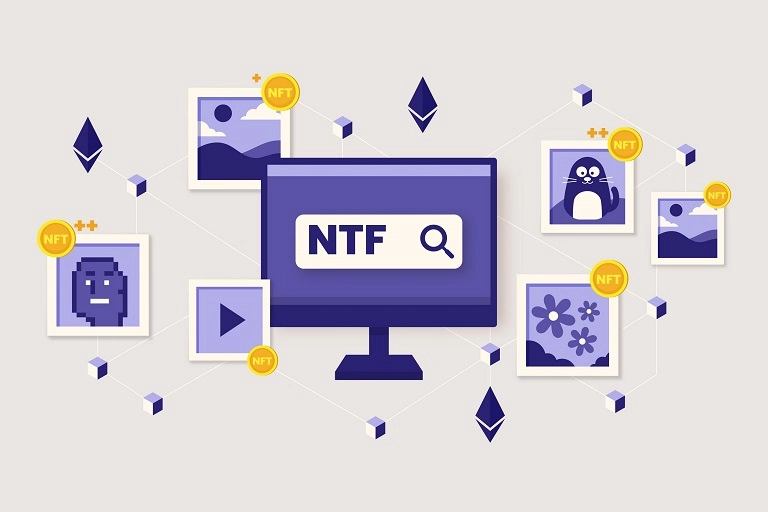The Future of Digital Art: The Rise of NFT Art Marketplaces
A friend of mine purchased some NFT for US$5,000 back in 2021. It’s worth a mere $15 today. That’s quite striking. Tales like this have inundated Twitter streams as users caught in the frenetic high of NFTs had bought tokens in anticipation of growth. The apparently bottomless NFT market went to dizzying heights.
NFT, short for non-fungible token, is a unique digital certificate recorded on a blockchain, representing ownership of an asset like an artwork or collectible. In 2021, “NFT” was chosen as Collins Dictionary’s “Word of the Year,” reflecting its explosive popularity. But how did it reach such prominence?
This recognition coincided with NFTs revolutionizing the art world, exemplified by Beeple’s digital artwork “Everydays: The First 5000 Days,” which sold for an astounding $69 million at Christie’s.
The NFT market has undergone a wild journey over the last few years. In 2021, it exploded, generating an estimated total sales volume of around $41 billion, fueled by excitement around art, collectibles, and play-to-earn games. In 2022, the market exceeded $100 billion, driven by further expansion into music, sports, and metaverse projects.
However, 2023 saw a sharp correction, with total volume dropping to around $25 billion due to macroeconomic challenges and market saturation. This decline has sparked debates about the sustainability of the NFT art market, while industry leaders still foresee potential for its resurgence.

You might now be asking: what caused NFT art to rise and then fall? This article will provide clarity and insights into the current and future state of the digital art market.
Why Did NFT Art Decline?
The once-thriving world of NFT art has dimmed recently, prompting soul-searching within the crypto community. While some see this as a temporary lull, others believe deeper flaws are at play. Let’s explore the key factors behind the decline of NFT art:
Crypto Winter: The broader cryptocurrency market has entered a bear phase, with Bitcoin and other major tokens dropping in value. NFTs, especially in the art sector, were largely driven by speculation, and the current downturn has dampened investors’ enthusiasm for high-priced digital art.
Hype Exhaustion: The initial hype surrounding NFTs, fueled by celebrity endorsements and record-breaking sales, has cooled. Overexposure to “get rich quick” schemes and scam projects has eroded trust, leaving many disillusioned. The market is also oversaturated with uninspired works, making it hard for collectors to find valuable pieces.
High Fees: Popular blockchains like Ethereum often impose significant gas fees for minting and trading NFTs, which can be a barrier for artists and collectors, limiting broader adoption.
Lack of Utility: Many NFT projects offer little more than ownership of a digital token. While some provide access to exclusive communities or in-game perks, these features often seem insufficient to justify high prices. This lack of intrinsic value weakens NFT art’s appeal compared to traditional art forms.
Emerging Concerns: Environmental sustainability and ethical issues have become more prominent in discussions about NFTs. The energy-intensive nature of blockchain networks, plagiarism concerns, and potential market manipulation are critical issues facing the space.
Regulatory Uncertainty: The legal framework surrounding NFTs is still unclear and inconsistent, complicating matters for creators and collectors. The lack of standardized regulations creates uncertainty about rights and responsibilities related to NFT ownership, hindering the market’s growth.
Recent data revealed that of 73,257 NFT collections, a staggering 95% have a market cap of zero ether, meaning millions of people now hold assets with no monetary value. This decline presents an opportunity for reflection and reinvention. Addressing the challenges with creative solutions and adding tangible value will be crucial for reviving the NFT art market.
However, despite these obstacles, the industry shows signs of renewal. For example, Sotheby’s recently introduced a peer-to-peer marketplace for digital art sales on Ethereum and Polygon blockchains, allowing collectors to trade digital works directly.
Why NFTs Are a Game-Changer for Artists, Galleries, and Collectors
NFTs introduce verifiable ownership and scarcity for digital creations, transforming how art is bought and sold. This innovation is reshaping the roles of artists, galleries, and collectors in the art ecosystem.
For Artists:
Democratized Access: NFT marketplaces allow artists to bypass traditional gatekeepers and reach a global audience. Regardless of reputation or location, artists can sell directly to collectors, fostering a more diverse art scene.
New Revenue Streams: NFTs enable artists to earn not only from initial sales but also from resales through royalties, providing financial stability and motivation for continued creation.
Enhanced Engagement: Artists can build deeper relationships with collectors, gaining feedback and inspiration while fostering community engagement.
For Galleries:
Diversification: Galleries can broaden their offerings by including digital art, attracting tech-savvy collectors and expanding into new markets.
Curated Experiences: Galleries can curate NFT collections, serving as tastemakers and offering collectors quality and authenticity.
Virtual Exhibitions: NFT art allows galleries to host virtual exhibitions, blending physical and digital experiences for a broader audience.
For Collectors:
Unique Ownership: NFTs guarantee ownership of unique digital art, avoiding issues of replication.
Fractional Ownership: NFTs enable collectors to share ownership of high-value art, democratizing access and fostering community investment.
Exclusive Benefits: NFT ownership often unlocks special experiences, such as access to communities, events, or future art releases.
The development of NFT marketplaces will further empower artists, galleries, and collectors to embrace this new frontier.
Where to Sell NFT Art in the Digital Landscape?
Aspiring NFT artists must navigate a crowded landscape of platforms. Let’s explore some key options:
Public Marketplaces:
OpenSea: Known for its vast user base and diverse collections, OpenSea offers an easy-to-use platform for artists at all levels. However, competition can be fierce, and discoverability may be a challenge.
Blur: Blur caters to seasoned traders with a focus on efficiency. Its tools, like sweep and snipe, enable fast purchases of multiple NFTs. This platform appeals to professional traders seeking quick market gains.
Specialized Marketplaces:
Digital Basel: This platform targets high-end NFT art with a curated experience. While exclusive, its selective process ensures exposure to serious collectors.
Niche Marketplaces: These platforms focus on specific art genres or communities, fostering a sense of belonging but may have limited reach.
Factors to consider when choosing a marketplace include fees, community engagement, and ease of use. For companies building their own NFT marketplace, it’s vital to offer the best financial and technical conditions for users.
Understanding the NFT Art Marketplace Landscape
The NFT art market is diverse, with platforms catering to different audiences. Some of the top platforms include:
- Blur: Specializing in fast trades and community engagement.
- OKX NFT Marketplace: Supporting multi-chain trading and offering zero-fee events.
- OpenSea: A broad platform with user-friendly features and a wide audience.
How to Build an NFT Digital Art Marketplace
Building a successful NFT art marketplace requires careful planning and technical expertise. Key steps include:
- Defining goals and target audience.
- Developing secure smart contracts.
- Designing a user-friendly interface.
- Implementing efficient royalty systems.
- Focusing on security and community engagement.
By addressing these elements, you can create a robust platform that meets the needs of modern digital artists.
Closing Remarks
The NFT art scene continues to evolve, offering artists, collectors, and platforms new opportunities. While challenges remain, the potential for growth is immense. If you are inspired to build your own NFT marketplace, Blockchain Studioz offers the expertise to bring your vision to life with custom solutions tailored to your needs.

Principal Consultant